Part 2:
- On the second part of the analysis of freestyle breathing patterns, we decided to look at the relationship between breathing rates and lap progression in 200m or longer reps.
- We looked again at Breaths per minute, Strokes per minute and Strokes per breath, this time as a function of rep progression.
- In Part 1, we saw that breathing rate and stroke rate were correlated: as breath rate increased, so too did stroke rate.
- We wanted to know: In a 200m+ effort, breathing rate is expected to increase after the initial laps as the toll of exercise increases the need for oxygen: How do swimmers breathing patterns change?
Patterns As a Function of Laps
- Here, as we also saw in Part 1, we see men tend to breathe more quickly than women overall, and younger swimmers breathe more than their older counterparts.
- We see that as oxygen requirements catch up to swimmers after the initial laps, breathing rates raise across the board, but women in particular increase their breath rates more than the men do due to the effort of swimming
- This higher ramp up of breathing rates may prepare women for their last laps: while the men continue to increase their breaths to the end, the women drop theirs.
- Does stroke rate naturally ramp up as a result of breathing rate increasing? We found that stroke rate actually decreases through the middle of the swim. This indicates that swimmers must be changing their breathing pattern to compensate.
- The median of Strokes per min on initial laps was around 68 for young boys (13-16y) and 62 for older men (17-25y). For women, the median was near 67 for young girls (13-16y) and 64 for older women (17-25y).
- Strokes per minute decreases for both genders and age groups as they swim, and then increases at the end, following a similar pattern as their pacing/speed.
- In this case though, through the middle of the swim we see breathing rates are increasing while stroke rates are decreasing, which indicates that swimmers will need to change their breathing patterns in order to take the extra breaths they need.
- And indeed, we see this effect on stroking patterns: to increase and decrease breath rates, stroking patterns change through the swim
- Women start near a 3:1 strokes to breath pattern and through the first 6 laps they take more and more of their breaths with the 2:1 pattern, in a very similar pattern for both age groups; as their breathing rate drops in the last two lengths, they go back to taking more strokes between every breath
- Men’s stroking patterns at the older ages are consistently closer to 2:1 than the younger boys, but both age groups also follow a similar progression pattern, taking fewer strokes between breaths with each lap in order to increase their breathing rate
Conclusions
- Breathing rates reflect how oxygen requirements ramp up during the effort of swimming, and women are more likely to starve themselves of oxygen in the last splits
- Since swimmers are breathing faster but stroking more slowly in the middle of a 200m+ swim, swimmers must decrease the number of strokes between breaths, ultimately sacrificing some streamlining to meet oxygen demands
VISIT THE TRITONWEAR HQ
FOLLOW US ON INSTAGRAM
LIKE US ON FACEBOOK
FOLLOW US ON TWITTER
Tritonwear is a SwimSwam partner.







I think you came to the wrong conclusion. You stated women are more likely to starve themselves of oxygen on the last lap with no evidence to support that. It’s equally likely or more likely that male swimmer are more starved for oxygen approaching the final 50 and have a similar end result. Assuming both males and females end their races in the same amount of oxygen dept. I also think looking at 200 time as sample groups instead of age may yield more interesting results.